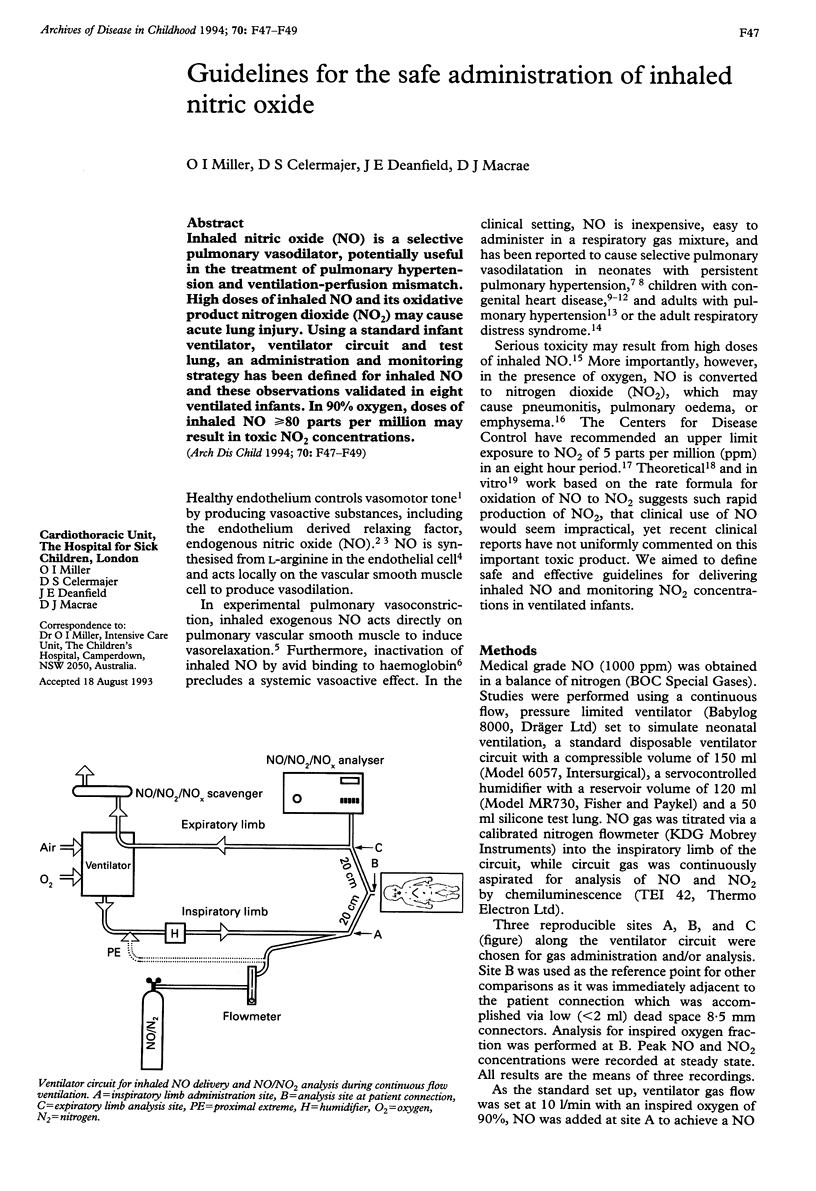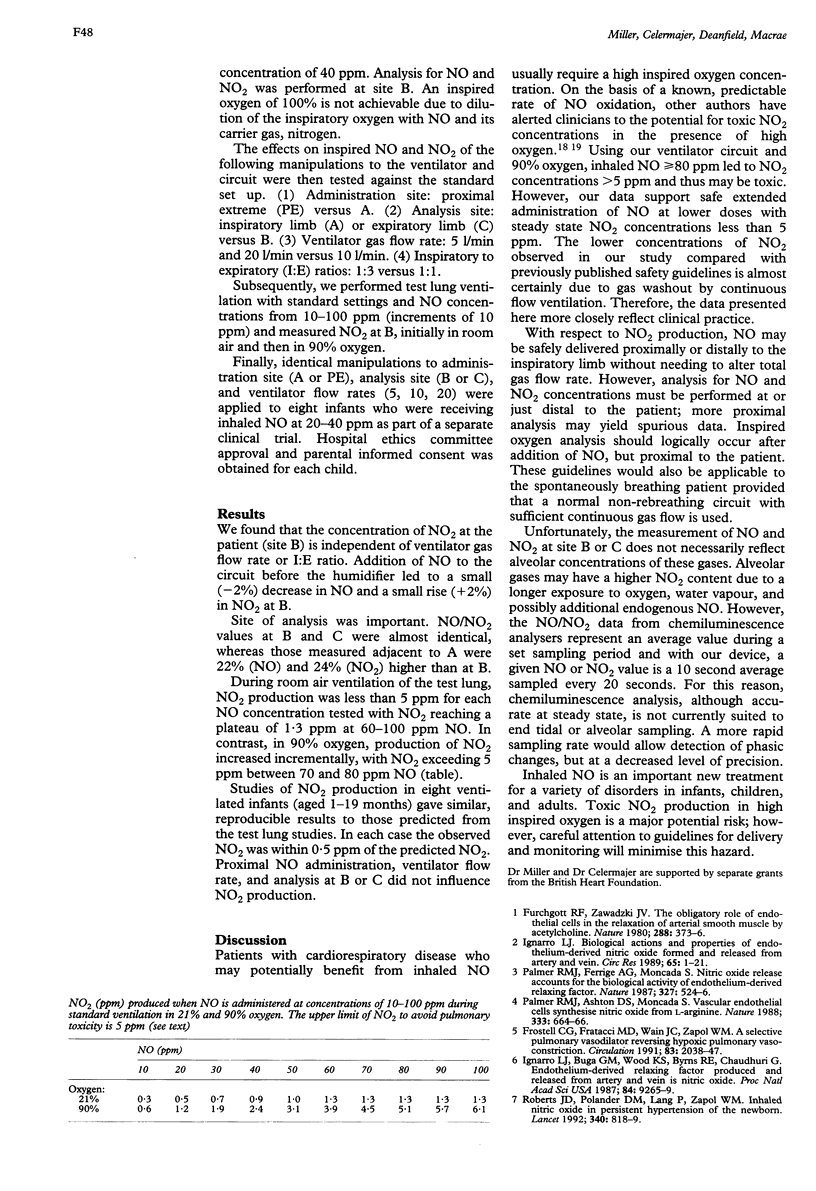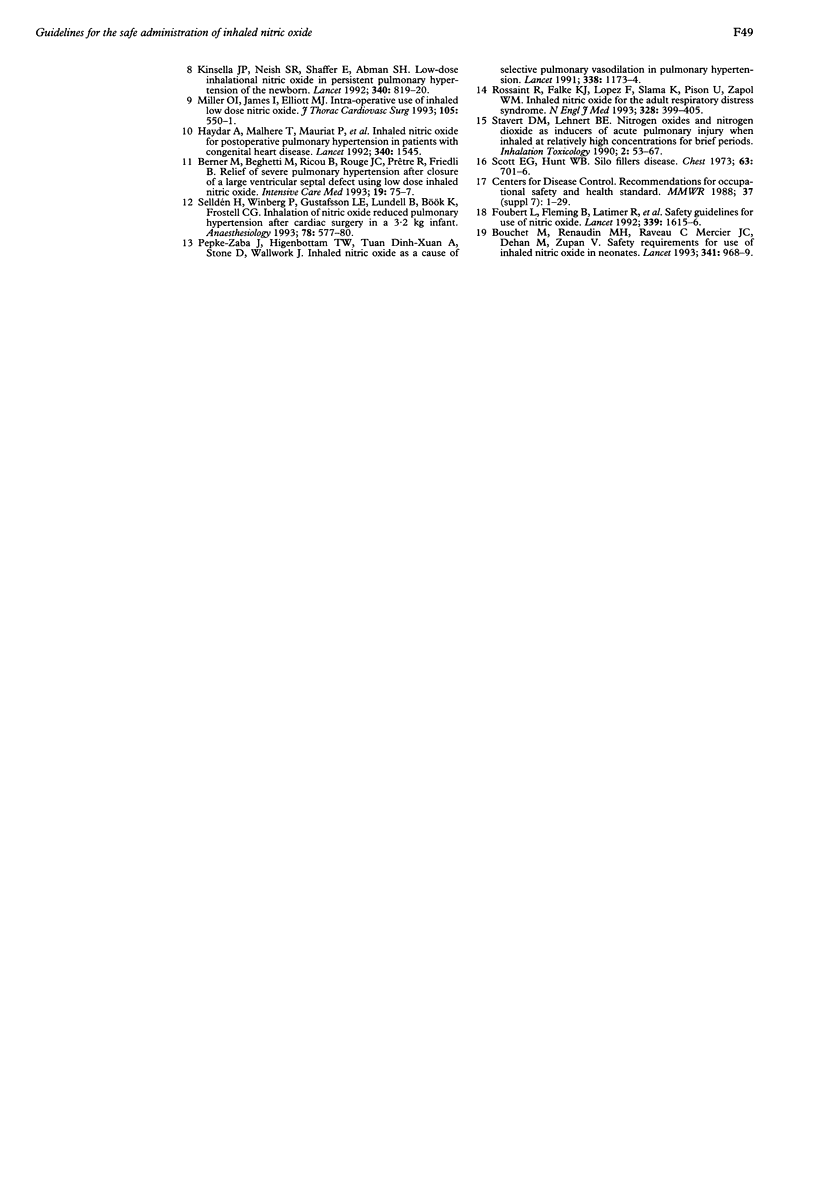Abstract
Inhaled nitric oxide (NO) is a selective pulmonary vasodilator, potentially useful in the treatment of pulmonary hypertension and ventilation-perfusion mismatch. High doses of inhaled NO and its oxidative product nitrogen dioxide (NO2) may cause acute lung injury. Using a standard infant ventilator, ventilator circuit and test lung, an administration and monitoring strategy has been defined for inhaled NO and these observations validated in eight ventilated infants. In 90% oxygen, doses of inhaled NO > or = 80 parts per million may result in toxic NO2 concentrations.
Full text
PDF


Selected References
These references are in PubMed. This may not be the complete list of references from this article.
- Berner M., Beghetti M., Ricou B., Rouge J. C., Prêtre R., Friedli B. Relief of severe pulmonary hypertension after closure of a large ventricular septal defect using low dose inhaled nitric oxide. Intensive Care Med. 1993;19(2):75–77. doi: 10.1007/BF01708365. [DOI] [PubMed] [Google Scholar]
- Bouchet M., Renaudin M. H., Raveau C., Mercier J. C., Dehan M., Zupan V. Safety requirement for use of inhaled nitric oxide in neonates. Lancet. 1993 Apr 10;341(8850):968–969. doi: 10.1016/0140-6736(93)91267-p. [DOI] [PubMed] [Google Scholar]
- Foubert L., Fleming B., Latimer R., Jonas M., Oduro A., Borland C., Higenbottam T. Safety guidelines for use of nitric oxide. Lancet. 1992 Jun 27;339(8809):1615–1616. doi: 10.1016/0140-6736(92)91886-d. [DOI] [PubMed] [Google Scholar]
- Frostell C., Fratacci M. D., Wain J. C., Jones R., Zapol W. M. Inhaled nitric oxide. A selective pulmonary vasodilator reversing hypoxic pulmonary vasoconstriction. Circulation. 1991 Jun;83(6):2038–2047. doi: 10.1161/01.cir.83.6.2038. [DOI] [PubMed] [Google Scholar]
- Furchgott R. F., Zawadzki J. V. The obligatory role of endothelial cells in the relaxation of arterial smooth muscle by acetylcholine. Nature. 1980 Nov 27;288(5789):373–376. doi: 10.1038/288373a0. [DOI] [PubMed] [Google Scholar]
- Haydar A., Malhere T., Mauriat P., Journois D., Pouard P., Denis N., Lefèbvre D., Safran D., Vouhé P. Inhaled nitric oxide for postoperative pulmonary hypertension in patients with congenital heart defects. Lancet. 1992 Dec 19;340(8834-8835):1545–1545. doi: 10.1016/0140-6736(92)92796-i. [DOI] [PubMed] [Google Scholar]
- Ignarro L. J. Biological actions and properties of endothelium-derived nitric oxide formed and released from artery and vein. Circ Res. 1989 Jul;65(1):1–21. doi: 10.1161/01.res.65.1.1. [DOI] [PubMed] [Google Scholar]
- Ignarro L. J., Buga G. M., Wood K. S., Byrns R. E., Chaudhuri G. Endothelium-derived relaxing factor produced and released from artery and vein is nitric oxide. Proc Natl Acad Sci U S A. 1987 Dec;84(24):9265–9269. doi: 10.1073/pnas.84.24.9265. [DOI] [PMC free article] [PubMed] [Google Scholar]
- Kinsella J. P., Neish S. R., Shaffer E., Abman S. H. Low-dose inhalation nitric oxide in persistent pulmonary hypertension of the newborn. Lancet. 1992 Oct 3;340(8823):819–820. doi: 10.1016/0140-6736(92)92687-b. [DOI] [PubMed] [Google Scholar]
- Miller O. I., James J., Elliott M. J. Intraoperative use of inhaled low-dose nitric oxide. J Thorac Cardiovasc Surg. 1993 Mar;105(3):550–551. [PubMed] [Google Scholar]
- Palmer R. M., Ashton D. S., Moncada S. Vascular endothelial cells synthesize nitric oxide from L-arginine. Nature. 1988 Jun 16;333(6174):664–666. doi: 10.1038/333664a0. [DOI] [PubMed] [Google Scholar]
- Palmer R. M., Ferrige A. G., Moncada S. Nitric oxide release accounts for the biological activity of endothelium-derived relaxing factor. Nature. 1987 Jun 11;327(6122):524–526. doi: 10.1038/327524a0. [DOI] [PubMed] [Google Scholar]
- Pepke-Zaba J., Higenbottam T. W., Dinh-Xuan A. T., Stone D., Wallwork J. Inhaled nitric oxide as a cause of selective pulmonary vasodilatation in pulmonary hypertension. Lancet. 1991 Nov 9;338(8776):1173–1174. doi: 10.1016/0140-6736(91)92033-x. [DOI] [PubMed] [Google Scholar]
- Roberts J. D., Polaner D. M., Lang P., Zapol W. M. Inhaled nitric oxide in persistent pulmonary hypertension of the newborn. Lancet. 1992 Oct 3;340(8823):818–819. doi: 10.1016/0140-6736(92)92686-a. [DOI] [PubMed] [Google Scholar]
- Rossaint R., Falke K. J., López F., Slama K., Pison U., Zapol W. M. Inhaled nitric oxide for the adult respiratory distress syndrome. N Engl J Med. 1993 Feb 11;328(6):399–405. doi: 10.1056/NEJM199302113280605. [DOI] [PubMed] [Google Scholar]
- Scott E. G., Hunt W. B., Jr Silo filler's disease. Chest. 1973 May;63(5):701–706. doi: 10.1378/chest.63.5.701. [DOI] [PubMed] [Google Scholar]
- Selldén H., Winberg P., Gustafsson L. E., Lundell B., Bök K., Frostell C. G. Inhalation of nitric oxide reduced pulmonary hypertension after cardiac surgery in a 3.2-kg infant. Anesthesiology. 1993 Mar;78(3):577–580. doi: 10.1097/00000542-199303000-00021. [DOI] [PubMed] [Google Scholar]


